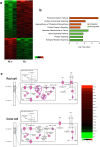Drinking hydrogen water improves photoreceptor structure and function in retinal degeneration 6 mice
- PMID: 35948585
- PMCID: PMC9365798
- DOI: 10.1038/s41598-022-17903-8
Drinking hydrogen water improves photoreceptor structure and function in retinal degeneration 6 mice
Abstract
Retinitis pigmentosa (RP) is a genetically heterogeneous group of inherited retinal disorders involving the progressive dysfunction of photoreceptors and the retinal pigment epithelium, for which there is currently no treatment. The rd6 mouse is a natural model of autosomal recessive retinal degeneration. Given the known contributions of oxidative stress caused by reactive oxygen species (ROS) and selective inhibition of potent ROS peroxynitrite and OH·by H2 gas we have previously demonstrated, we hypothesized that ingestion of H2 water may delay the progression of photoreceptor death in rd6 mice. H2 mice showed significantly higher retinal thickness as compared to controls on optical coherence tomography. Histopathological and morphometric analyses revealed higher thickness of the outer nuclear layer for H2 mice than controls, as well as higher counts of opsin red/green-positive cells. RNA sequencing (RNA-seq) analysis of differentially expressed genes in the H2 group versus control group revealed 1996 genes with significantly different expressions. Gene and pathway ontology analysis showed substantial upregulation of genes responsible for phototransduction in H2 mice. Our results show that drinking water high in H2 (1.2-1.6 ppm) had neuroprotective effects and inhibited photoreceptor death in mice, and suggest the potential of H2 for the treatment of RP.
© 2022. The Author(s).
Conflict of interest statement
The authors declare no competing interests.
Figures







Similar articles
-
Wheel running exercise protects against retinal degeneration in the I307N rhodopsin mouse model of inducible autosomal dominant retinitis pigmentosa.Mol Vis. 2019 Aug 21;25:462-476. eCollection 2019. Mol Vis. 2019. PMID: 31523123 Free PMC article.
-
PARP1 gene knock-out increases resistance to retinal degeneration without affecting retinal function.PLoS One. 2010 Nov 23;5(11):e15495. doi: 10.1371/journal.pone.0015495. PLoS One. 2010. PMID: 21124852 Free PMC article.
-
Protective effects of hydrogen-rich saline against N-methyl-N-nitrosourea-induced photoreceptor degeneration.Exp Eye Res. 2016 Jul;148:65-73. doi: 10.1016/j.exer.2016.05.017. Epub 2016 May 20. Exp Eye Res. 2016. PMID: 27215478
-
Photoreceptor cell death mechanisms in inherited retinal degeneration.Mol Neurobiol. 2008 Dec;38(3):253-69. doi: 10.1007/s12035-008-8045-9. Epub 2008 Nov 4. Mol Neurobiol. 2008. PMID: 18982459 Review.
-
Optical Coherence Tomography of Animal Models of Retinitis Pigmentosa: From Animal Studies to Clinical Applications.Biomed Res Int. 2019 Oct 30;2019:8276140. doi: 10.1155/2019/8276140. eCollection 2019. Biomed Res Int. 2019. PMID: 31781647 Free PMC article. Review.
Cited by
-
Oral Intake of Hydrogen Water Improves Retinal Blood Flow Dysregulation in Response to Flicker Stimulation and Systemic Hyperoxia in Diabetic Mice.Transl Vis Sci Technol. 2024 Oct 1;13(10):36. doi: 10.1167/tvst.13.10.36. Transl Vis Sci Technol. 2024. PMID: 39446362 Free PMC article.
-
APOA2: New Target for Molecular Hydrogen Therapy in Sepsis-Related Lung Injury Based on Proteomic and Genomic Analysis.Int J Mol Sci. 2023 Jul 11;24(14):11325. doi: 10.3390/ijms241411325. Int J Mol Sci. 2023. PMID: 37511084 Free PMC article.
-
Novel Role of Molecular Hydrogen: The End of Ophthalmic Diseases?Pharmaceuticals (Basel). 2023 Nov 7;16(11):1567. doi: 10.3390/ph16111567. Pharmaceuticals (Basel). 2023. PMID: 38004433 Free PMC article. Review.
-
The effect of hydrogen gas on the oxidative stress response in adipose tissue.Sci Rep. 2024 Sep 13;14(1):21425. doi: 10.1038/s41598-024-72626-2. Sci Rep. 2024. PMID: 39271809 Free PMC article.
-
Effect of molecular hydrogen, a novelly-established antioxidant, on the retinal degeneration of hereditary retinitis pigmentosa: an in-vivo study.Front Pharmacol. 2024 Apr 3;14:1294315. doi: 10.3389/fphar.2023.1294315. eCollection 2023. Front Pharmacol. 2024. PMID: 38638334 Free PMC article.
References
Publication types
MeSH terms
Substances
LinkOut - more resources
Full Text Sources
Medical

